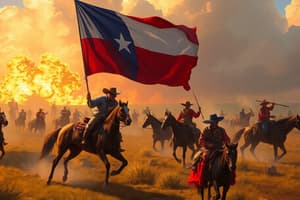Podcast
Questions and Answers
Who was the first President of the Republic of Texas?
Who was the first President of the Republic of Texas?
Houston
Who was the second President of the Republic of Texas?
Who was the second President of the Republic of Texas?
Lamar
What were the prominent political parties in mid-century Texas?
What were the prominent political parties in mid-century Texas?
- Know-nothings (correct)
- Democrats (correct)
- Whigs (correct)
- Republicans (correct)
What was the Santa Fe Expedition?
What was the Santa Fe Expedition?
What was the Mier Expedition?
What was the Mier Expedition?
What was a deciding factor for Texas secession?
What was a deciding factor for Texas secession?
What was Sam Houston's response to secession?
What was Sam Houston's response to secession?
What were 'Texas Troubles'?
What were 'Texas Troubles'?
What mode of transportation was prominent in mid-nineteenth century Texas?
What mode of transportation was prominent in mid-nineteenth century Texas?
What political climate characterized mid-century Texas?
What political climate characterized mid-century Texas?
Flashcards are hidden until you start studying
Study Notes
Government in Texas at time of Independence
- Texas declared independence from Mexico in 1836.
- It adopted a constitution establishing a republican government with a president, Congress, and a Supreme Court.
- The first president of the Republic of Texas was Sam Houston.
Primary culture in Texas at time of Independence
- Texas had a diverse population at the time of independence, including Anglo-American settlers, Tejanos, enslaved Africans, and Native Americans.
- The majority of the population was Anglo-American, with a strong emphasis on frontier culture and individualism.
- The economy relied largely on agriculture, especially cotton.
First President of Republic of Texas (Houston)
- Sam Houston was a skilled politician and military leader.
- Advocated for a policy of peace with Mexico, believing it would facilitate Texas's recognition as an independent nation.
Second President of Republic of Texas (Lamar)
- Mirabeau B. Lamar, Houston's successor, was a fervent expansionist.
- He favored a more aggressive stance towards Mexico, leading to the Santa Fe Expedition.
- Lamar also aimed to relocate Native American tribes to reservations further west.
Politics of Caution
- Advocated for a cautious approach to Texas's future, prioritizing peace and recognition by other nations.
- Advocated for a slower pace of expansion and a focus on economic development.
Politics of Action
- Emphasized aggressive expansion of Texas territory.
- Favored taking a stance against the possibility of further Mexican attacks and annexing lands from Mexico, despite the potential risks and international complications.
- Advocated for a more active posture toward Indigenous populations, seeking to remove them from crucial territories.
Santa Fe Expedition
- A 1841 expedition led by Texas Rangers with ambitions of conquering Santa Fe and expanding Texas's territory into New Mexico.
- Though initially successful, the expedition ended in disaster when its members were captured by the Mexican authorities.
- It underscored the risk and limitations of Texas's expansionist ambitions.
Mier Expedition
- A 1842 military operation with the aim of capturing Mexican territory.
- The Texan force was ultimately defeated and captured.
- Despite the defeat, the expedition was a display of Texan military capability and solidified its reputation as a formidable force.
Annexation from Texas perspective
- Texans desired annexation to the United States for several reasons:
- Increased security from Mexico: They hoped to secure their independence from Mexico, which still claimed sovereignty over the territory.
- Economic benefits: They believed access to the US market would boost their economy and promote growth.
- A more powerful international position: They sought the backing of the US to assert their claims and influence on the world stage.
- However, the US's decision to annex Texas was part of a complex political landscape.
Annexation from United States perspective
- The annexation of Texas was a contentious issue in the US, driven by political tensions over slavery.
- Pro-annexation forces argued Texas's inclusion would help solidify the South's political power and expand the territory for the expansion of slavery.
- Anti-annexation forces opposed the expansion of slavery and saw Texas's annexation as a threat to the balance of power between slave and free states.
Transportation in Mid-nineteenth century Texas
- Transportation in the mid-19th century was often difficult and slow.
- The absence of a robust railroad network made travel challenging except along waterways.
- Texans relied heavily on horse-drawn wagons, stagecoaches, and river boats for transportation.
Texas society at mid-century
- Texas underwent rapid population growth in the mid-19th century, driven by Anglo-American settlement.
- The economy continued to rely heavily on agriculture, particularly cotton production.
- Slavery remained a crucial aspect of Texas's economy and society.
Slavery in Texas
- Slavery was deeply entrenched in Texas society, supporting its economy and cultural norms.
- The issue of slavery was often linked to Texas's identity and political affiliations.
- A source of both economic power and moral debate, it would ultimately contribute to the state's secession.
Mid-century Texas politics
- The political landscape in mid-19th century Texas was dominated by two main parties: Democrats and Whigs.
- The Democrats were generally pro-slavery and favored expansionism.
- The Whigs, though sometimes less united over slavery, often held a more cautious approach to expansionism.
Democrats
- Advocated for the expansion of slavery and the acquisition of new territories.
- They were largely pro-Southern interests and were supportive of the expansion of states' rights.
- Prominent Democratic figures included Sam Houston and Hardin Runnels.
Whigs
- They were less united on the expansion of slavery, though the party generally opposed it.
- They often favored a more moderate approach to Texas's expansionist ambitions and emphasized economic development.
Know-Nothings
- A nativist party that emerged in the mid-19th century, known for their anti-immigrant and anti-Catholic sentiments.
- They sought to limit the influence of immigrants, particularly from Ireland and Germany, who were thought to be a threat to American values.
Republicans
- The Republican Party was a new force in American politics, rising to prominence in opposition to the expansion of slavery.
- Though it did not gain substantial support in Texas until after the Civil War, the party's rise challenged the dominance of the Democrats and contributed to political tension that led to secession.
Hardin R. Runnels vs. Sam Houston
- Hardin R. Runnels, a Democrat, defeated Sam Houston, a Whig, in the 1857 gubernatorial election amidst a volatile political scene.
- The 1857 election marked a shift in Texas politics as the Democrats consolidated their power.
Gubernatorial elections of 1857 & 1859
- The 1857 and 1859 elections were defined by the rising tensions over slavery and the secession of the South.
- Though not directly about secession, they reflected the emerging political divisions that would ultimately lead to the state's choice to secede.
Deciding factors for Texas secession
- The increasing national friction over the expansion of slavery was a major driving force for Texas's decision to secede.
- The election of Abraham Lincoln in 1860, a candidate seen as a threat to slavery's future, galvanized public support for secession.
- Texas perceived secession as a means to preserve its interests and uphold its way of life in the face of perceived federal encroachment.
Sam Houston's response to secession
- Sam Houston, a staunch unionist, opposed the secession of Texas and believed it would lead to disaster.
- He resigned his position as senator in protest of secession and even condemned it publicly, though he did not directly attempt to prevent it.
- He became a symbolic figure for those within Texas who opposed secession.
North Texas Counties in 1860
- The majority of North Texas counties were more aligned with the Union due to diverse demographics and economic interests.
- These counties remained more resistant to calls for secession, largely influenced by a growing sense of loyalty to the Union and its democratic principles.
"Texas Troubles"
- Refer to a period of turmoil and violence that erupted in Texas during the Civil War.
- This included raids by Confederate and Union forces, as well as conflicts between different factions within Texas.
- This period highlighted the complexities of the war in Texas, with its own internal divisions and conflicts intertwined with the broader national struggle.
Studying That Suits You
Use AI to generate personalized quizzes and flashcards to suit your learning preferences.




